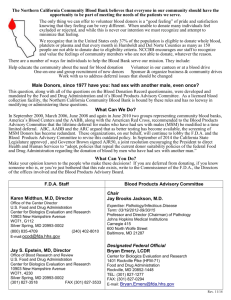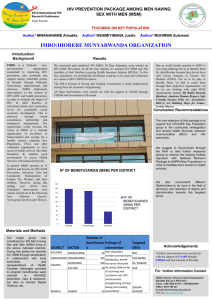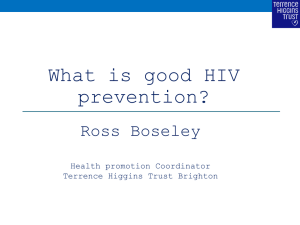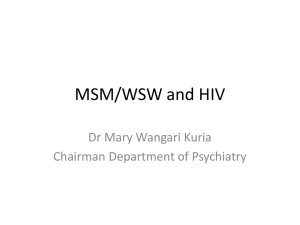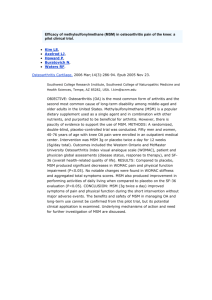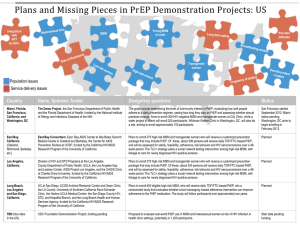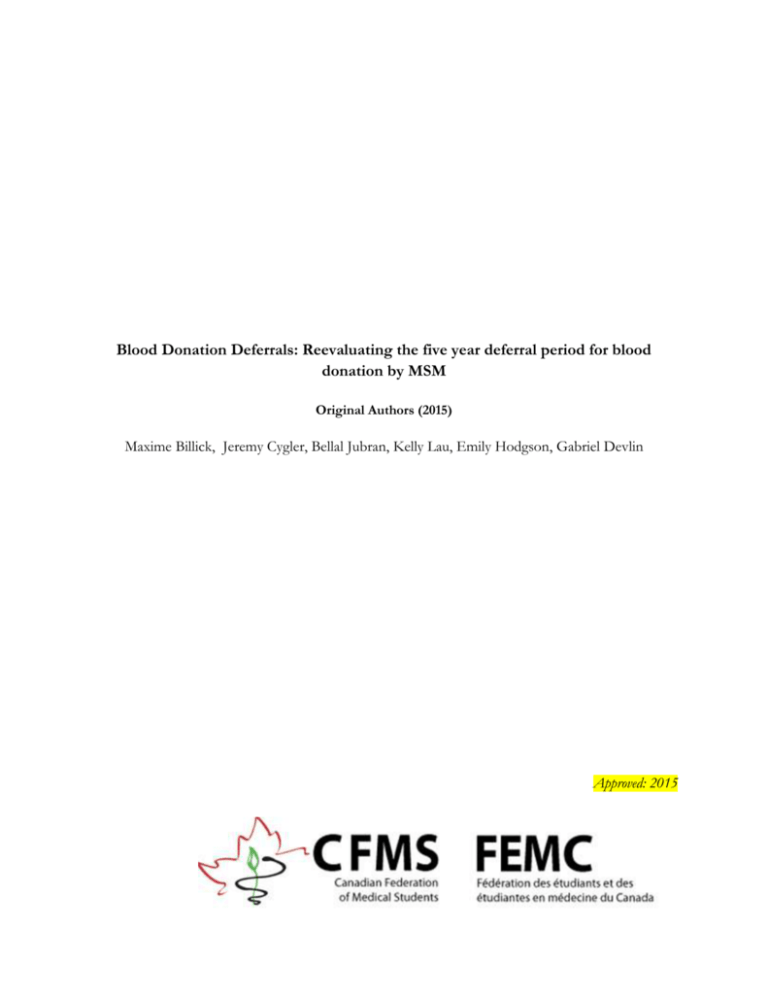
Blood Donation Deferrals: Reevaluating the five year deferral period for blood
donation by MSM
Original Authors (2015)
Maxime Billick, Jeremy Cygler, Bellal Jubran, Kelly Lau, Emily Hodgson, Gabriel Devlin
Approved: 2015
Background
Every year, Canadian Blood Services (CBS) collects approximately 900 000 units of blood from
across Canada (1). This supply is used in the transfusion of trauma victims, surgical patients, and in
many other medical circumstances. In order to protect the integrity of the blood supply and to
promote the safety of the blood recipients, CBS has instituted exclusion criteria for donors based on
demographic information and medical history. One example of such exclusion is the current policy
for men who have sex with men (MSM), who can only donate after a deferral period of five years
after their last sexual contact with a man. Hema-Quebec, which follows the standards set by Health
Canada, enforces the same donor exclusion criterion (3). Although CBS explains this policy as
reflective of the higher rates of HIV among the MSM population, some have called into question
the need for such a deferral (2) with recent medical advances in HIV testing1. Given these advances
and the Canadian Blood Service’s constant efforts to increase their base of blood donors, the role of
the 5-year deferral policy for MSM must be reassessed. The following document aims to present this
policy in more detail, discuss its relation to the principles of the CFMS, and contrast it with other
policy options, as implemented in other countries. Finally, a more modernized alternative will be
presented in light of this discussion.
Problem Description
Since 1983, Health Canada has supported and Public Health Canada has regulated the policies that
restrict MSM from donating blood to varying degrees (4). The policy was modified in 2013 from a
lifetime ban to a 5-year deferral period. Although congruent with current policy in many developed
countries, this issue returned to public attention with the United States Food and Drug
Administration’s (FDA) change in policy from a lifetime ban to a 1-year deferral period announced
in December of 2014 (5). In a press release, the FDA alluded to “the results of several recently
completed scientific studies and recent epidemiologic data,” as well as collaborative efforts with the
Department of Health and Human Services (HHS) which justified the change in policy (5).
Firstly, it is fundamental to consider the social context in which any change can occur. Recent
changes have in part been spurred by social momentum seeking to combat discrimination against,
and marginalization of, sexual minorities. A poll conducted by Ipsos Reid on behalf of the Canadian
Blood Services looked at public perception to change what was a lifetime ban (the policy in 2012) to
the five-year deferral period instituted in 2013 (6). The survey found that “[t]here is resounding
support for the MSM policy change among the […] Canadian Federation of Students […] with 8 in
10 who feel it is a step in the right direction and who strongly support the change; the majority of
donors also support the change (53% right direction and 61% support). General public respondents
express moderate support for the change (40% right direction and 45% support) and are most likely
1
Nucleic Acid Amplification testing (NAT or NAAT) is a relatively new tool used to detect viral or
bacterial infection. This technique has successfully shortened the window period, the time between
infection and earliest possible detection.
to indicate they are undecided.” (6) Thus, this poll showed that there was public support for a
change in deferral policy in 2012, particularly among students, and we believe that similar social
support exists for further re-examination of the policy.
With recent triggers for policy re-consideration, it is important to understand the social, legopolitical and economic context in which MSM blood donation policy. In the past, the main concerns
used to justify the ban were an increased prevalence and incidence of HIV amongst MSM, and a
history of blood supply contamination, presumably by MSM. According to an epidemiologic
summary by the Public Health Agency of Canada in 2011 (more recent data will be available later in
2015), about 46.7% of individuals living with HIV are MSM, while those who identify as
heterosexual account for a total of 32.5%. The same report cites that 46.6% of incident infections
are attributable to MSM, with heterosexual incidence accounting for a total of 37.2% (7).
Furthermore, certain historical events are often cited as support for prolonged deferral periods. For
instance, the distribution of contaminated blood products by the Canadian Red Cross (predecessor
to CBS and Hema-Quebec) in the late 1980s and early 1990s resulted in about 1200 Canadians
infected with HIV and about 25 000 infected with Hepatitis C. Although not attributed to donations
by MSM, this event is cited as a potential risk if policy on donation is relaxed. Given the higher
prevalence of HIV among MSM compared to the general population and the absence of any
effective screening methods, banning high-risk groups from donating blood was arguably the only
option available to limit blood contamination.
However, the situation today has changed compared to when the MSM deferral period was
originally put into place. First, HIV screening tools have dramatically improved compared to 1983.
Current blood donor screening employs a mix of pre-donation interviewing and serologic screening,
with test sensitivities and specificities approaching 100% (9) (see table below). In addition, the
window period has shrunk significantly from a 3-6 month period using the antibody tests (e.g.
OraQuick) to a 2-3 week period with the introduction of the Nucleic Acid Test (e.g. Multispot) (9).
Because of these new screening tools, the current risk of HIV contaminated blood entering the
blood system shrank to 1 per 8 to 12 million donations (10). In comparison, the risk a blood product
being contaminated with hepatitis B is 1 in 1.1 to 1.7 million, and the risk for hepatitis C is 1 in 5 to
7 million (10). In fact, according to one FDA official, “our current risks are now so low that they
cannot be measured directly and, hence, we rely on models to estimate the current residual risk, that
is to say the risk after all the safeguards have been followed” (11). Indeed, according to another
FDA official, “the probability that errors in routine screening will result in release of a unit [with
hepatitis C virus or HIV] is so remote as to be inconsequential” (11). These conclusions are
supported by quantitative modeling studies. For example, one study using Hema-Quebec data from
2000-2001 found that changing the current policy to a one-year deferral would increase the risk of
inadvertent HIV transmission by 1 in 11 million; this represents a small fraction of the current
“tolerated” risk of 1 per 2 million donations (12). Given the quantitative evidence and the
experience of other countries with 1-year deferral periods for MSM who wish to donate blood, both
the American Red Cross and the American Association of Blood Banks have argued that the current
policy “is medically and scientifically unwarranted” (11). The American Association of Blood Banks
has specifically argued that “the longest window required to detect HIV in blood was one year,
making a deferral lasting more than one year unwarranted.”
Table 1: HIV Screening Methods for Blood Products
Test
Manufacturer
Sample Type
OraQuick Advance Rapid
OraSure
Oral Fluid
HIV1/2 Antibody Test
Technologies
Whole Blood
Plasma
Clearview Complete HIV1/2 Inverness Medical
Whole Blood
Professional
Serum and Plasma
Diagnostics
Clearview HIV1/2 STATInverness Medical
Whole Blood
PAK
Professional
Serum and Plasma
Diagnostics
Reveal G-3 Rapid HIV-1
MedMira, Inc
Serum
Antibody Test
Plasma
Uni-Gold Recombingen
Trinity Biotech
Whole Blood
HIV
Serum and Plasma
Multispot HIV-1/HIV-2
Bio-rad Laboratories Serum
Rapid Test
Plasma
INSTI HIV-Antibody test
bioLytical
Plasma
Laboratories
Whole
blood
(venipuncture)
Whole
blood
(finger stick)
Sensitivity
99.3%
99.6%
99.6%
99.7%
99.7%
Specificity
99.8%
100%
99.9%
99.9%
99.9%
99.7%
99.7%
99.9%
99.9%
99.8%
99.8%
100%
100%
100%
100%
99.9%
99.9%
99.1%
98.6%
99.7%
99.8%
99.9%
99.9.%
100%
100%
99.8%
99.5%
Note: many of these tests are a combination of nucleic acid and antibody testing.
Despite advancements in screening technology, proponents of unnecessarily lengthy deferral periods
warn of the potential rise of a new pathogen that could infect the blood supply. This argument,
however, assumes that any new blood borne threats would preferentially emerge among MSM, and
evidence suggests this is not the case. Out of the 8 emerging transfusion-transmitted agents
identified by the American Association of Blood Banks as “high risk,” none are more likely to
accumulate in MSM than in other donors (12).
The legal and political milieu must also be considered and evaluated when attempting to understand
the context of MSM blood donation. This necessitates a discussion of the changing lego-political
environment surrounding LGBTTQ (lesbian, gay, bisexual, transgender, two-spirit, and queer) issues
at both federal and provincial levels. Multiple recent legislative events highlight steps taken to
recognize the basic rights of individuals from the LGBTQ community and the major hurdles to
changing the status quo in our current political atmosphere. One such example is the Civil Marriage
Act, passed in 2005. An analysis of the voting pattern within the House of Commons shows that
there was a considerable number of candidates from both the Liberal backbenches and the
Conservative party (34% and 95% respectively) who voted against such legislation. In fact, 51% of
the House of Commons voted against the bill (13). This highlights that controversy surrounding
LGBTQ issues is significant within the legislative sphere, which is a challenge to changing MSM
blood deferral policy.
On a provincial level, multiple rulings have addressed the issue of legal restrictions on members of
the LGBTQ community. For example, in the ruling of Blood Services v. Freeman in 2010, the Ontario
Superior Court upheld what was then an indefinite ban on MSM blood donation, based on
epidemiological evidence. The Court also stated that the right to marry did not logically lead to the
right to donate blood. Notwithstanding the fact that such a ruling relied on prevalence rather than
detection methods, this ruling is a recent example of behavioural restrictions placed on members of
the LGBTQ community.
One must also consider the potential benefits of an updated policy for the recipients of blood
products. Relaxing the deferral period to one year would moderately increase the number of blood
donors. One study using data from the United States and Canada found that the change in policy
would increase the blood supply by 1-2% (14). Another study by the Fenway Institute – an
American research, education, training and advocacy organization – calculated that the change
would add 317 000 pints of blood to the United States’ annual blood supply, or an increase of 2-4%
(15). This increase may be especially significant given that the blood supply continues to be critically
low in Canada; as recently as September 2014, Canadian Blood Services claimed its blood supply was
in a “critical situation” and “at its lowest since 2008” (16). A change in policy could also indirectly
increase the number of blood donations, given that “some student societies, universities and other
organizations have stopped holding blood drives because of the indefinite deferral of men who have
sex with men.” (17) Despite the potential for making available an entire group of people who could
significantly contribute to eradicating this deficit, reducing the ban to one year for MSM blood
donation has not been approved.
Lastly, it is important to consider differing international policy options in order to better adapt
successes to a Canadian milieu and to learn from their challenges. Policies are clearly being updated
worldwide to reflect recent understandings of sexual behaviour and changes to testing and screening
processes. Several countries have implemented 1-year deferral policies for blood donations by MSM,
including Australia and the UK. Other countries, including Italy, Spain, and Mexico, have
implemented individual risk stratification strategies with no specific deferral period for MSM (18). In
Italy, the risk assessment is conducted by a physician and applied to all individuals regardless of
gender or sexual orientation. In a joint study completed by the National Institute of Health and the
Bologna Local Health Authority published in 2013, the authors compared the percentage of HIV
positive donors based on sexual status before and after the change in policy. Results showed that
there was “no evidence of significant impact on the HIV epidemic in Italy.” (19)
In England, Scotland and Wales, a new policy of a 1-year deferral after sexual contact for MSM was
instituted in 2011. This change was made in response to an evidence-based policy review by the
Advisory Committee on the Safety of Blood, Tissues and Organs, in which they determined that the
risks associated with a 1-year deferral were analogous to those posed by a lifetime ban. Additionally,
they acknowledged that a policy of individual risk assessment would be ideal, but it was seen to be
“complex, expensive and difficult to administer in a donation session.” (20) A survey conducted by
the committee found that a 1-year deferral (as compared to a 5-year deferral) conferred eligibility to
46% of MSM respondents (20).
Finally, Australia changed its policy from a permanent ban to a 1-year deferral period between 1996
and 2000. A study conducted between 2005 and 2010 found that there was “no evidence for
increased risk of transfusion-transmitted human immunodeficiency virus in Australia subsequent to
implementing a 12-month deferral for men who have had sex with men.”(21) Of the 4 964 628
donations evaluated, 24 were HIV positive, 16 of whom were male. 5 of those 16 had male-to-male
sex as a risk factor, and all 5 men had engaged in sex with another male within the past 12 months,
and therefore would have been excluded from donating had they provided an accurate history (21).
This brings up the issue of compliance with the proposed deferral period. Seed et al. admit that
“[t]he risk of noncompliance to the revised deferral rather than its duration appears to be the most
important modifier of overall risk.” (21) The UK Advisory Committee on the Safety of Blood,
Tissues, and Organs also stated that “compliance remains a key issue when considering any change
to deferral criteria as non-compliance may lead to an increase in undetected window-period
infection.” (20) However, another study conducted by Seed et al. found that, in a sample of nearly
15 000 male donors, the compliance with the current 12-month deferral policy in Australia is greater
than 99.7% (22). This strongly alleviates concerns raised over decreased compliance with a new
policy.
The demographic of HIV in Canada has changed significantly in the past few decades. When HIV
reporting to the Public Health Agency of Canada (PHAC) began in 1985, MSM accounted for over
80% of all cases of HIV infection. Between 1980 and 2005, MSM exposure accounted for 58.0% of
positive HIV test reports. This number dropped to 38.9% in 2006 and 48.6% in 2011, although the
absolute number of positive tests decreased (520 in 2006 compared to 509 in 2011). In 2011, the
second most important exposure to HIV amongst adults was through heterosexual contact,
representing 29.5% of positive HIV tests. Heterosexual contact was in fact the main risk factor for
females, present in 64.5% of positive HIV test reports. The third most important exposure was
injection drug use (IDU), which accounted for 17.0% of positive tests amongst adults, and 29.9% of
positive tests in women. Furthermore, the overall number of positive HIV reports is steadily
decreasing. Only 151 cases were reported in 2011, which was 31.7% lower than the previous year,
and over 12 times fewer cases than the 1,827 cases reported in 1993 (the highest number for a single
year in Canada). Thus, the landscape of the HIV-positive population has shifted steadily over the
past 40 years. Today, heterosexual contact and IDU represent a significant proportion of new HIV
infections in Canada (23).
In summary, the current deferral period for blood donation by MSM was instituted at a time when
testing methods for blood borne diseases were inferior to current methods, and these diseases had a
much higher prevalence in the MSM population. For these reasons, the time has come to reconsider
this policy. Technological progress has resulted in screening tools with specificity and sensitivity near
to 100%, leading to a very low risk of undetected infections entering the blood supply. Furthermore,
social and legal movements have arisen lately seeking to combat the marginalization of the LGBTQ
community. One-year deferral policies have been instituted in various countries across the globe,
and existing data does not suggest any increased rates of HIV in the blood supply. Although this
paper is not meant to be a discussion of the “right to donate blood,” we do recognize that placing
unnecessarily rigid limits on the ability to contribute to the healthcare system is unjustifiably
exclusionary. We are therefore suggesting a change in the current policy from a 5-year deferral to a
1-year deferral.
Principles
The 5-year deferral period for MSM blood donations is not compatible with the CFMS’ values due
to the lack of evidence, the inequitable principles and the inconsistency with the needs of the
Canadian population that underpin the policy. With improvements in blood screening technologies
and shifting patterns of risk for HIV transmission, the evidence supporting the assumption that a 5year deferral period is safer than a 1-year deferral period is unsubstantiated and translates into unfair
practices.
According to the Canadian Medical Association code of ethics, physicians should “[c]onsider
the wellbeing of society in matters affecting health.” As physicians in training, one of our major
responsibilities is to address the needs of the Canadian population, and one of the most precious
resources is the Canadian blood bank. Reducing the 5-year deferral period for MSM to one year will
increase the pool of healthy potential donors and ultimately expand blood resources available to the
public. The direct benefits of increasing the blood pool as well as the evidence supporting reduced
risk of HIV contamination with improved technologies will not only reduce costs and challenge
institutionalized stigma, but will save lives.
Recommendations
1. Reduce the current 5-year deferral period for MSM donors to a 1-year deferral period.
Banning MSM from donating blood was an understandable policy in 1983 given the high prevalence
of HIV among MSM, the absence of effective screening HIV methods, and the epidemic of
transfusion-borne HIV infections. However, as screening technology has improved, this policy has
become outdated and is misaligned with current epidemiological and quantitative evidence. We
believe decreasing the current deferral period for MSM to one year would align Health Canada’s
policy with those of many other nations worldwide, including the United States, Japan, Brazil, the
United Kingdom, and Australia. A one-year deferral would also align the current MSM policy with
that for other high-risk groups, such as donors who have had sexual contact with an HIV-positive
partner. Finally, we believe that changing the current policy would increase the Canadian blood
supply and help limit the impact of shortages.
CITATIONS
1. Canadian Blood Services [Internet]. [Place unknown] Blood Donation Champion Toolkit; 2014 [cited
2015 Feb 15]. Available from: https://www.blood.ca/sites/default/files/whatisbloodfor.pdf
2. Cohen, IG, Feigenbaum, J, Adashi, EY. Reconsideration of the Lifetime Ban on Blood Donation by
Men Who Have Sex With Men. JAMA. 2014 July; 312(no.4):337-338.
3. Héma-Québec [Internet]. [Place Unknown] Héma-Québec; 2014 [cited 2015 March 18]. Available
from: https://www.hema-quebec.qc.ca/sang/donneur-sang/puis-je-donner/homme-ayant-eu-unerelation-sexuelle-avec-un-homme.en.html
4. Belli M. The Constitutionality of the ‘Men Who Have Sex With Men’ Blood Donor
5.
6.
7.
8.
9.
10.
11.
12.
13.
14.
Exclusion Policy. (2003) J.L. in Society 315 at 338; Canadian Blood Services, Record of
Donation, online: Canadian Blood Services – Société canadienne du sang – Donor
Questionnaire .
Hamburg, M. US Food and Drug Administration [Internet]. [Place unknown] FDA; 2014
[cited 2015 January 21]. Available from:
http://www.fda.gov/NewsEvents/Newsroom/PressAnnouncements/ucm427843.htm
Canadian Blood Services [Internet]. [Place unknown] Ipsos Reid Survey; 2012 [cited 2015
Feb 18]. Available from: https://www.blood.ca/sites/default/files/2012-ipsos-reid-surveyresults.pdf
Canada. Infection Disease Prevention And Control. Summary: Estimates of HIV Prevalence
and Incidence in Canada, 2011. Ottawa: Public Health Agency of Canada; 2012.
Hochberg FA. HIV/AIDS and Blood Donation Policies: A Comparative Study of Public
Health Policies and Individual Rights Norms. Duke Journal of Comparative & International
Law. 2002; 12: 231-280.
Slev P. The Changing Landscape of HIV Diagnostics. MLO Med Labs Obs. 2012; 44(11): 810,12,14.
MacDonald N, O’Brien SF, Delage G. Transfusion and Risk of Infection in Canada: Update
2012. Paediatr Child Health. 2012; 17(10): 102-111.
Food and Drug Administration. FDA workshop on behavior-based donor deferrals in the
NAT era [Internet]. Bethesda; 2006. Available from: www.fda.gov/downloads/Biologics
BloodVaccines/NewsEvents/WorkshopsMeetingsConferences/TranscriptsMinutes/UC054
430.pdf (accessed 2015 March 21).
Vamvakas C. Relative Risk of Reducing the Lifetime Blood Donation Deferral for Men Who
Have Had Sex With Men Versus Currently Tolerated Transfusion Risks. Transfusion
Medicine Reviews. 2011; 25(1): 47-60.
Parliament of Canada [Internet]. Ottawa: Parliament of Canada; 2005 [cited on 2015 Feb 20].
Available from:
http://www.parl.gc.ca/LegisInfo/BillDetails.aspx?Language=E&billId=1585203&Mode=1
&View=5
Germain M, Remis RS, Delage G. The risks and benefits of accepting men who have had sex
with men as blood donors. Transfusion. 2003; 43: 25-33.
15. Tavernise S. F.D.A. Easing Ban on Gays, to Let Some Give Blood. New York Times
[Internet]. 2014 Dec 23 [cited 2015 Feb 17]. Available from: http://tinyurl.com/qxk7xan
16. McGinn D. Canada’s Blood Supply in a ‘Critical Situation,’ Agency Says. The Globe and
Mail [Internet]. 2014 Oct 1 [cited 2015 Feb 17]. Available from: http://tinyurl.com/pl8e958
17. Wainberg M, Shuldiner T, Dahl K, Gilmore N. Reconsidering the Lifetime Deferral of
Blood Donation by Men Who Have Sex with Men. CMAJ. 2010; 182(12): 1321–1324.
18. Millman J. Why The FDA’s Expected Decision to End a Ban on Blood Donations From
Gay Men May Fall Short. Washington Post [Internet]. 2014 Dec 2 [cited 2015 Feb 23].
Available from: http://tinyurl.com/jwj4v2b
19. Suligoi B, Pupella S, Regine V, Raimondo M, Velati C, Grazzini G. Changing blood donor
screening criteria from permanent deferral for men who have sex with men to individual
sexual risk assessment: no evidence of a significant impact on the human immunodeficiency
virus epidemic in Italy. Blood Transfusion. 2013; 11(3): 441-448.
20. United Kingdom.Advisory Committee on the Safety of Blood, Tissues, and Organs. Donor
Selection Criteria Review. London; 2011.
21. Seed CR, Kiely P, Law M, Keller AJ. No evidence of a significantly increased risk of
transfusion-transmitted human immunodeficiency virus infection in Australia subsequent to
implementing a 12-month deferral for men who have had sex with men. Transfusion. 2010;
50(12): 2722-2730.
22. Seed CR, Lucky TT, Wally D, Wand H, Lee JF, Wroth S, et al. Compliance with the current
12-month deferral for male-to-male sex in Australia. Vox Sanguinis. 2014; 106(1): 14-22.
23. Canada. Public Health Agency of Canada. HIV and AIDS in Canada Surveillance Report to
December 31, 2011. Ottawa: Public Health Agency of Canada; 2012.

